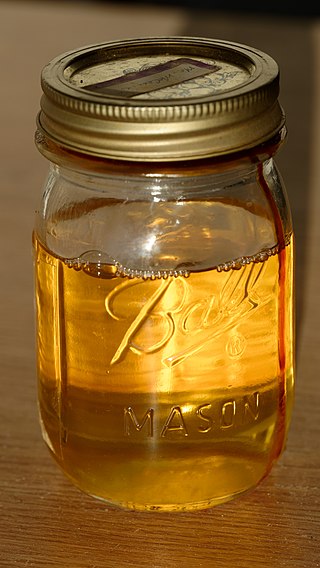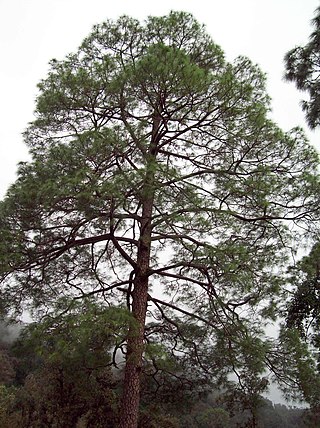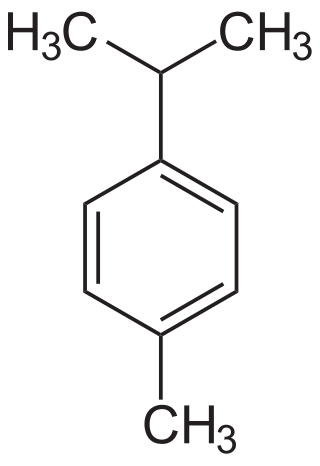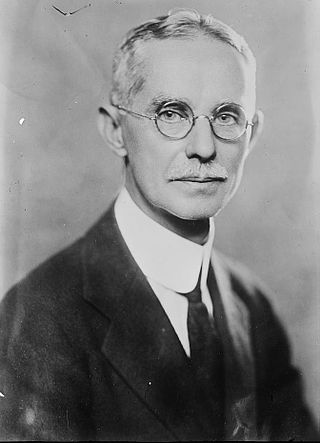
A resin is a solid or highly viscous liquid that can be converted into a polymer. Resins may be biological or synthetic in origin, but are typically harvested from plants. Resins are mixtures of organic compounds, and predominantly terpenes. Well known resins include amber, hashish, frankincense, myrrh and the animal-derived resin, shellac. Resins are commonly used in varnishes, adhesives, food additives, incenses and perfumes.

Turpentine is a fluid obtained by the distillation of resin harvested from living trees, mainly pines. Principally used as a specialized solvent, it is also a source of material for organic syntheses.

Varnish is a clear transparent hard protective coating or film. It is not to be confused with wood stain. It usually has a yellowish shade due to the manufacturing process and materials used, but it may also be pigmented as desired. It is sold commercially in various shades.
Rosin, also known as colophony or Greek pitch (Latin: pix graeca), is a resinous material obtained from pine trees and other plants, mostly conifers. The primary components of rosin are diterpenoids, i.e., C20 carboxylic acids. Rosin consists mainly of resin acids, especially abietic acid. Rosin often appears as a semi-transparent, brittle substance that ranges in color from yellow to black and melts at stove-top temperatures.

The longleaf pine is a pine species native to the Southeastern United States, found along the coastal plain from East Texas to southern Virginia, extending into northern and central Florida. In this area it is also known as "yellow pine" or "long leaf yellow pine", although it is properly just one out of a number of species termed yellow pine. It reaches a height of 30–35 m (98–115 ft) and a diameter of 0.7 m (28 in). In the past, before extensive logging, they reportedly grew to 47 m (154 ft) with a diameter of 1.2 m (47 in). The tree is a cultural symbol of the Southern United States, being the official state tree of Alabama. This particular species is one of the eight pine tree species that falls under the "Pine" designation as the state tree of North Carolina.

Weymouth Woods-Sandhills Nature Preserve is a North Carolina state park in Moore County, North Carolina in the United States. Located near Southern Pines, North Carolina, it covers 915 acres (3.70 km2) in the Sandhills region of the state. Weymouth Woods is the location of the oldest known longleaf pine tree on record, a tree that was cross-dated at 458 years old.

Dammar, also called dammar gum, or damar gum, is a resin obtained from the tree family Dipterocarpaceae in India and Southeast Asia, principally those of the genera Shorea or Hopea. The resin of some species of Canarium may also called dammar. Most is produced by tapping trees; however, some is collected in fossilised form on the ground. The gum varies in colour from clear to pale yellow, while the fossilised form is grey-brown. Dammar gum is a triterpenoid resin, containing many triterpenes and their oxidation products. Many of them are low molecular weight compounds, which easily oxidizes and photoxidizes.

Pinus roxburghii, commonly known as chir pine or longleaf Indian pine, is a species of pine tree native to the Himalayas. It was named after William Roxburgh.

Naval stores refers to the industry that produces rosin, turpentine, tall oil, pine oil, and other oleoresin collected from conifers. The term was originally applied to the compounds used in building and maintaining wooden sailing ships. Presently, pine compounds produced by the naval stores industry are used to manufacture soap, paint, varnish, shoe polish, lubricants, linoleum, and roofing materials.

Charles Holmes Herty Sr. was an American academic, scientist, and entrepreneur. Serving in academia as a chemistry professor to begin his career, Herty concurrently promoted collegiate athletics including creating the first varsity football team at the University of Georgia. His academic research gravitated towards applied chemistry where he revolutionized the turpentine industry in the United States. While serving as the president of the American Chemical Society, Herty became a national advocate for the nascent American chemical industry and left academia to preside over the Synthetic Organic Chemical Manufacturers' Association (SOCMA) and the Chemical Foundation. He was also instrumental in the creation of the National Institutes of Health. Towards the end of his career, Herty's research and advocacy led to the creation of a new pulp industry in the Southern United States that utilized southern pine trees to create newsprint.

Fatwood, also known as "fat lighter", "lighter wood", "rich lighter", "pine knot", "lighter knot", "heart pine", "fat stick" or "lighter'd" [sic], is derived from the heartwood of pine trees. The stump that is left in the ground after a tree has fallen or has been cut is the primary source of fatwood, as the resin-impregnated heartwood becomes hard and rot-resistant after the tree has died. Wood from other locations can also be used, such as the joints where limbs intersect the trunk. Although most resinous pines can produce fatwood, in the southeastern United States the wood is commonly associated with longleaf pine, which historically was highly valued for its high pitch production.

In plantation forests in parts of Europe, the tree stumps left after felling are now sometimes pulled out of the ground to supply wood fuel for biomass power stations. The stump is the base of the trunk and the attached woody roots. Tree stumps and roots are extracted using a hydraulic head on a tracked excavator or with a mechanical head equipped by a special tool for tractors. Stump harvesting is expected to provide an increasing component of the woody material required by the woody biomass power sector in Europe.

Resin extraction consists of incising the outer layers of a pine tree in order to collect the sap or resin.
Gum copal is a resin produced by the sap of forest tree in the genus Daniellia. Due to common impurities and differences in regions, gum copal ranges in color from black to yellow to white. Gum copal, along with ivory and slaves, was a significant export from East Africa in the 19th century. It can have an appearance similar to amber and may be mistaken for it. Unlike amber, gum copal is usually only 100–1,000 years old and it has not yet fossilized.
Geneva State Forest is an Alabama state forest in Geneva County, Alabama in the United States. The forest is 7,120 acres (2,880 ha) and sits at an elevation of 210 feet (64 m). It is Alabama's largest state forest. According to the Alabama Forestry Commission the primary objective of the state forest is to provide timber for the lumber industry and the secondary objectives are to provide habitats for wildlife and recreational opportunities for people. The forest is open for year-round recreation including hunting, fishing, hiking and camping.

Levopimaric acid is an abietane-type of diterpene resin acid. It is a major constituent of pine oleoresin with the chemical formula of C20H30O2. In general, the abietene types of diterpene resin acid have various biological activities, such as antibacterial, cardiovascular and antioxidant. Levopimaric acid accounts for about 18 to 25% of pine oleoresin. The production of oleoresin by conifer species is an important component of the defense response against insect attack and fungal pathogen infection.

Heart pine refers to the heartwood of the pine tree, which is the non-living center of the tree trunk, while the sapwood is the outer living layer which transports nutrients.
"Pecherei" is the common expression in southern Lower Austria for the practice of Resin Extraction from black pine trees (Evergreens). This profession centers around the extraction of tree resin, also known as "Pitch," that will ultimately be used in the production of further chemical products. Those who extract resin for a living are described as "Pecher" or "Resin Workers." In the year 2011, Pecherei was incorporated into the register of Intangible Cultural Heritage in Austria, which was drafted in the context of the UNESCO Convention for the Preservation of Intangible Culture.

L.O. Crosby Sr. was an American businessman and timber industrialist in Mississippi. During his 50 years as an active industrialist, Crosby owned thousands of acres of southern pine timberlands and numerous sawmills for converting trees into lumber. He initiated construction of creosote treatment plants for preserving wood products, a tung-oil processing facility, and naval store facilities for extracting pine rosin from stumps that were removed from cutover forestlands.

Vladimir Viktorovich Shkatelov was a Russian and Soviet chemical technologist and was the founder of forest chemistry in Belarus. He held a Doctor of Chemical Sciences degree, was an Academician of the National Academy of Sciences of BSSR (1929), and was honored as a Distinguished Scientist of BSSR (1938). Shkatelov authored over 60 scientific works on forest and agricultural technology. He is known for his leadership in pioneering industrial experiments in tapping deciduous trees and directing research on wood hydrolysis. He was a key figure in establishing the tapping and rosin-turpentine industry in the USSR. Among the first researchers to identify the superior quality of Russian turpentine. Shkatelov also developed innovative methods for processing resin and analyzed the chemical composition of resins




















